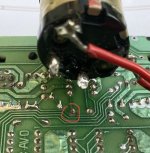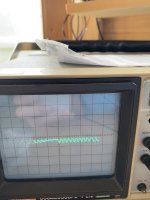miata
Experienced Member
Hi, made some progress today. The sound is now working again. After hunting with my scope again and again I came to my limit without having the proper schematic. I simply did not know where the signal goes further.
So, I de- installed the logic board again and followed the traces with my multimeter and magnifying glasses. And finally I found the culprit. There is a trace going to Pin3 of the amplifier chip (Sound input) and running very close to a capacitor I replaced a few months ago. I obviously slightly damaged the trace while removing the cap (desoldering gun too hot?). Not really visible on the glance. Arrgh
I did install a bodge wire and put the system back together. Now MineStorm is running with sound. Hurrah
Next problem solved. Now I will hunt for the missing video. I guess I will look to the transistors I mentioned above.
Cheers
Denis
So, I de- installed the logic board again and followed the traces with my multimeter and magnifying glasses. And finally I found the culprit. There is a trace going to Pin3 of the amplifier chip (Sound input) and running very close to a capacitor I replaced a few months ago. I obviously slightly damaged the trace while removing the cap (desoldering gun too hot?). Not really visible on the glance. Arrgh
I did install a bodge wire and put the system back together. Now MineStorm is running with sound. Hurrah
Next problem solved. Now I will hunt for the missing video. I guess I will look to the transistors I mentioned above.
Cheers
Denis














